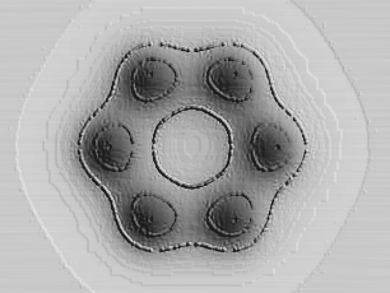Metal−π Interactions
Bonds are everything – for chemists. Bonds between charged particles, electron sharing bonds, and, of course, the bonds between molecule and metal that exist so widely, the metal-π bonds. Indeed, if conventional ionic and covalent bonds are the meat and vegetables on the chemical structure menu, then π interactions are the spice that adds variety with a metallic tang.
The interaction between a metal atom and an aromatic surface in a molecular entity are widespread, found throughout biological processes among countless proteins, their active centers and their substrates, in supramolecular host-guest structures, in polymer and materials design and manufacture, in innumerable catalytic reactions. The same interactions are also exploited in analytical chemistry in electrospray mass spectrometric applications. Among the most common and perhaps best studied is the special relationship between silver and π electrons. Nevertheless, details of the characteristics of Ag-π interactions remain elusive.
Using Molecular Torsion to Measure Weak Attractions
A team at the University of South Carolina, Columbia, USA, has designed and built a series of molecular torsion balances for measuring the strength of individual interactions between silver(I) ions and π systems in solution. The idea is to provide definitive, experimental evidence of the strength of attraction between silver and π orbitals. “A better understanding of the individual interaction strengths and stability trends is still needed to guide the rational design of new materials and applications that utilize this interaction,” the reseachers explain.
The team – Josef Maier, Ping Li, Jungwun Hwang, Mark Smith, and Ken Shimizu – points out that silver-π interactions, despite their relevance and fascination, are weak and therefore difficult to isolate and measure in solution. To tackle this problem, they use a torsion balance with an N-arylimide bicyclic framework that can essentially flip between two states, a folded and an unfolded one. The researchers can attach silver to a pyridine nitrogen atom on one side of this “padlock”.
When the silver is facing away from the aromatic phenyl ring at the opposite end, the padlock is open (unfolded) but the silver can move into a position where it is in close proximity to that aromatic ring and thus close (fold) the padlock as a silver-π interaction occurs. The team was able to verify that a well-defined intramolecular silver-π interaction exists in their model systems using X-ray crystallography and proton nuclear magnetic resonance (NMR) spectroscopy.
A Weak, but Stabilizing Interaction
Measurements based on the stabilization of the padlock when a Ag-π interaction forms pin down its strength to be between −1.34 and −2.63 kcal/mol. The strength of this interaction is on par with other non-covalent interactions of charged species, such as charge-assisted hydrogen bonds, the team reports. The small values obtained using this approach go some way to explain why measuring the strength of this interaction has been so difficult in the past. It has also been difficult to form a stable and analytical tenable structure success with which hinges on a single silver-π interaction. The researchers noted how seemingly trivial changes in geometry and environment as well as the charge-draining effect of silver being coordinated to a nitrogen atom can affect the strength of the interaction substantially. The team is working with variations on their approach to measure other interactions of metal with various π surfaces.
Bonding expert Scott Cockroft, University of Edinburgh, UK, told ChemViews Magazine that, “Shimizu’s paper is a great piece of work.” He points out that: “Chemistry is a mature field, and one of the results of this is that classically trained inorganic, physical and organic chemists have developed slightly different frameworks for rationalizing their observations. However, when different metals and organic molecules get together, interesting and exciting things can, and do, occur, (as is beautifully illustrated by chemical and biological catalysis), and long-standing simplistic models may not apply.” He explains: “The insights into silver-π interactions obtained by Shimizu and co-workers contribute to the development of a truly unified understanding of the sometimes unexpected phenomena that can occur when the worlds of physical organic and inorganic chemistry collide.”
- Measurement of Silver−π Interactions in Solution Using Molecular Torsion Balances,
Josef M. Maier, Ping Li, Jungwun Hwang, Mark D. Smith, Ken D. Shimizu,
J. Am. Chem. Soc. 2015.
DOI: 10.1021/jacs.5b04554

